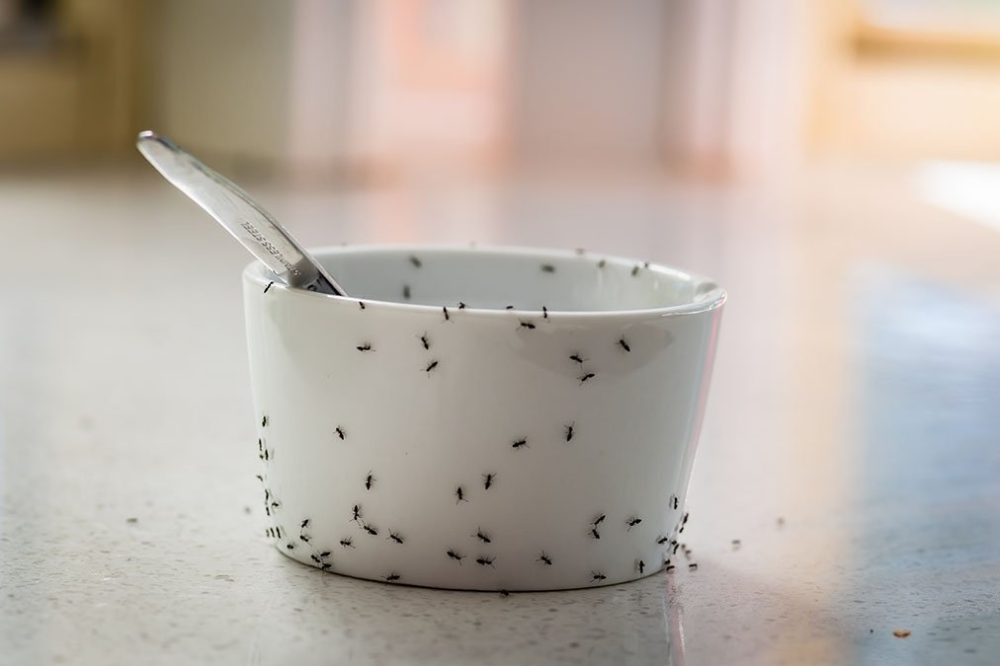A trail of tiny black ants marching across your kitchen counter can be a frustrating sight.
Whether they’re swarming your countertops, infiltrating your pantry, or appearing near food scraps, little black ants are one of the most common household pests, particularly in the kitchen.
While these ants may seem harmless at first, they can quickly become a nuisance, especially when they find their way into your food supplies.
In this article, we’ll explore why tiny black ants invade your kitchen, how to identify them, and provide effective strategies to eliminate them and prevent future infestations.
What Are Tiny Black Ants?
Tiny black ants, also known as Monomorium minimum, are small, dark-colored ants that typically measure between 1/16 to 1/8 inch in length.
These ants are typically black or dark brown and have a smooth, shiny body. They are often seen in large numbers and are highly social, forming long trails as they search for food and water.
Unlike larger ant species that are drawn to specific types of food, tiny black ants are generalist feeders.
They are attracted to a wide range of food sources, including sugary foods, grease, protein, and even pet food, making your kitchen a prime target for infestation.
Why Are Tiny Black Ants in Your Kitchen?
Tiny black ants are constantly searching for food and water, which makes your kitchen an ideal place for them to invade.
Here are some common reasons why these ants may be invading your kitchen:
1. Food Sources
Your kitchen offers an abundance of food sources that ants find irresistible.
Even small crumbs, spilled sugar, open food containers, or dirty dishes left in the sink can attract these tiny invaders.
Ants are particularly drawn to sugary substances, but they’ll also seek out greasy foods, fruits, and even pet food.
2. Water Sources
Ants need water to survive, and your kitchen likely provides plenty of moisture sources.
Leaky faucets, damp sponges, pet water bowls, or even condensation from your refrigerator can attract ants in search of hydration.
3. Easy Entry Points
Ants can enter your home through even the smallest cracks and gaps. Your kitchen, with its pipes, vents, and doors, is a prime entry point.
Once they find an opening, they can form trails that lead to food or water sources.
4. Nesting Sites
While ants are foraging for food, they may also be looking for a place to nest.
Kitchens, with their warmth and accessibility, provide suitable conditions for ants to establish colonies.
These nests may be hidden in walls, under appliances, or in cracks and crevices in cabinets or floors.
How to Identify Tiny Black Ants
To deal with a tiny black ant infestation, it’s important to know what you’re dealing with. Here’s how you can identify them:
- Size: Tiny black ants are very small, typically measuring between 1/16 and 1/8 inch in length. If the ants you’re seeing are larger or smaller, they may belong to a different species.
- Color: These ants are typically black, but some may appear dark brown or reddish.
- Behavior: Tiny black ants are often seen in long, narrow trails as they forage for food and water. They will typically follow the same path repeatedly, so if you spot one, you can often trace it back to the nest.
- Body Structure: They have a smooth, slender body with a narrow waist, which is characteristic of many ant species. Their small size and shiny black color make them distinguishable from other ant types.
How to Get Rid of Tiny Black Ants in the Kitchen
If you’ve noticed tiny black ants in your kitchen, it’s time to take action. Here are some effective ways to eliminate them:
1. Clean Your Kitchen Thoroughly
The first step to eliminating ants is to remove the food and water sources that are attracting them. Start by cleaning your kitchen thoroughly:
- Wipe down surfaces: Make sure countertops, tables, and stovetops are free of crumbs, spills, and food debris.
- Clean behind appliances: Check areas behind the refrigerator, stove, and microwave where food particles can accumulate.
- Empty trash regularly: Don’t let garbage sit around for too long, as it can attract ants searching for food.
- Store food properly: Keep food in airtight containers to prevent ants from accessing it. This includes pantry items like sugar, flour, rice, and cereal, as well as pet food.
2. Seal Entry Points
Ants can enter your home through tiny cracks and gaps, so it’s important to seal any potential entry points in your kitchen. Check areas around:
- Doors and windows
- Gaps around plumbing pipes
- Cracks in the walls or flooring
- Vents and baseboards
Use caulk, weather stripping, or sealant to close these gaps. This will help prevent new ants from entering your kitchen.
3. Use Ant Baits
Ant baits are one of the most effective ways to eliminate tiny black ants.
The baits contain a slow-acting poison that worker ants carry back to their colony, eventually killing the queen and the rest of the colony. Here’s how to use ant baits:
- Place the baits: Set up the baits along ant trails or in areas where you’ve seen the most activity.
- Be patient: Ants may take several days to bring the bait back to the colony, so it’s important to give it time to work.
- Avoid disturbing the baits: Let the ants do their job and avoid cleaning or removing the baits during this process.
4. Natural Remedies
If you prefer non-toxic methods, there are several natural repellents that can help deter ants from entering your kitchen:
- Vinegar Solution: Mix equal parts white vinegar and water in a spray bottle. Spray it directly on ants, along their trails, or around entry points. Vinegar disrupts ants’ scent trails and repels them.
- Cinnamon: Sprinkle ground cinnamon along areas where you’ve seen ants. Ants dislike the strong scent of cinnamon, and it can act as a deterrent.
- Diatomaceous Earth: This fine powder can be sprinkled around cracks and crevices or along ant trails. It works by dehydrating ants, eventually killing them.
5. Insecticidal Sprays
If the infestation is severe and DIY methods aren’t working, you may need to resort to insecticidal sprays.
Look for an insecticide that is safe for use in the kitchen, especially if it’s an area where you prepare food.
Always read and follow the manufacturer’s instructions, and be sure to ventilate the area properly after applying.
6. Call a Pest Control Professional
If the infestation is persistent or you can’t locate the nest, it may be time to call in a professional pest control service.
A pest control expert can identify the source of the infestation, locate the nest, and apply targeted treatments to eradicate the ants.
| Problem | Solution | Tip |
|---|---|---|
| Food Attraction | Clean up food sources and spills immediately | Wipe down counters, sweep floors, and store food in airtight containers. |
| Water Sources | Eliminate excess moisture and fix leaks | Dry wet areas, fix leaking faucets or pipes, and change damp towels. |
| Ant Entry Points | Seal cracks, gaps, and openings | Use caulk or weather stripping to seal cracks around doors, windows, and plumbing. |
| Finding the Ant Nest | Use ant baits or professional pest control | Place baits along ant trails; consult a pest control expert if the problem persists. |
| Persistent Infestation | Use insecticidal sprays or natural repellents | Use a non-toxic solution like vinegar or diatomaceous earth, or apply targeted sprays. |
| Preventing Future Infestations | Regular cleaning and maintenance | Clean your kitchen and bathrooms frequently, and inspect your home for entry points regularly. |
| Ant Trails | Disrupt scent trails and block their paths | Use a vinegar solution or cinnamon around trails to confuse and deter ants. |
| Nesting Inside Walls or Floors | Call a pest control professional | Professionals can locate and treat hidden nests within walls or under floors. |
| Pet Food or Pantry Issues | Store pet food and pantry items securely | Keep pet food sealed and pantry items in airtight containers. |
Preventing Future Ant Problems in the Kitchen
Once you’ve dealt with the current infestation, there are several preventive measures you can take to ensure that ants don’t return:
1. Maintain Cleanliness
Regularly clean your kitchen, especially high-traffic areas like countertops, sink areas, and floors. Sweep up crumbs, wipe down counters, and clean dishes immediately after use. This will remove food sources that ants find irresistible.
2. Store Food Properly
Keep food in sealed containers, and avoid leaving food out overnight. Store sugar, flour, cereal, and pet food in airtight containers to prevent access for ants.
3. Fix Leaky Faucets
Ants need water to survive, so any leaky pipes or faucets in your kitchen can attract them. Fix leaks promptly to eliminate one of the key resources that ants are after.
4. Seal Cracks and Gaps
Periodically inspect your kitchen for cracks and gaps around windows, doors, plumbing pipes, and baseboards. Use caulk or weather stripping to seal these openings and prevent ants from entering your home.
5. Use Ant Deterrents
Consider using natural ant deterrents around the kitchen, such as cinnamon, citrus peels, or essential oils like peppermint or tea tree oil.
These scents can help repel ants and keep them from returning.

Conclusion
Tiny black ants in the kitchen can be a persistent problem, but with the right approach, you can eliminate them and prevent future infestations.
By maintaining cleanliness, sealing entry points, and using targeted treatments like ant baits or natural remedies, you can reclaim your kitchen from these pesky invaders.
Remember, the key to keeping ants out of your kitchen is vigilance—regularly check for food sources and potential entry points, and take immediate action when you spot ants.
With a little effort, you can keep your kitchen clean, safe, and ant-free.



